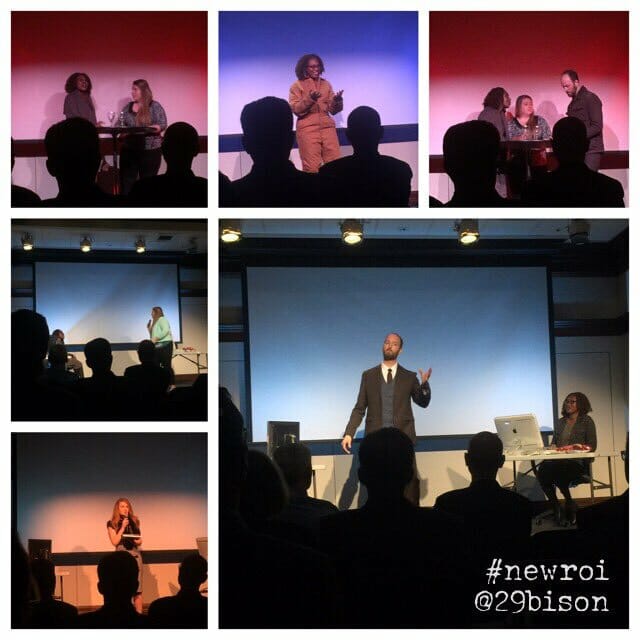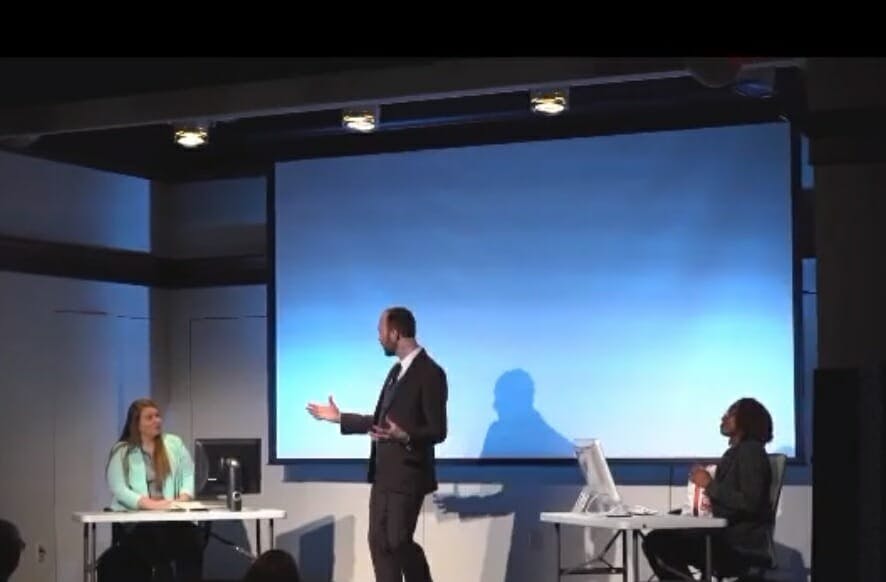Editor’s note: Have you ever heard of a business book, particularly one focused on talent management, being turned into a play? Probably not since How to Succeed In Business Without Really Trying. But that’s just what two Philadelphia business people have done. Laura Queen, founder and CEO of human capital advisory firm, 29Bison, and executive coach Mare Rosenbaum staged The New ROI: Return on Individuals. Based on the book of the same name (excerpted here on TLNT), the play was written by Bill D’Agostino.
Dave Bookbinder is the author of The New ROI.
∼∼∼∼∼
The idea for The New ROI Experience came from a desire to visualize the thesis of the book – that people really are an organization’s most valuable asset – through a series of vignettes that create real workplace experiences from the book’s central concepts.
Laura stated: “We operate in a business environment that places significant value on tangible assets like buildings and equipment; and intangible assets like relationships with customers and organizational brands. The most important assets however, are employees – the human capital.”
It’s been proven by numerous studies that high levels of employee engagement translate into stronger levels of fiscal performance and companies that focus on doing right by their employees exhibit stock returns that exceed those of their peers.
Unfortunately, human capital assets aren’t reported on the balance sheet.
According to Mare: “Our responsibility is to move this conversation forward, so that the value of individuals is accounted for in an extrinsic way. You and I are responsible for creating better work experiences for our employees, so that we, they, and all of our stakeholders reap the rewards.”
The production
The story of the production explores the merger of two mid-sized life sciences companies. There is tremendous pressure on both organizations to meet the internal and external expectations for success.
Following are brief summaries of the performance’s vignettes:
“Transito”
With her company recently acquired by the Acme Corporation, Susan, a highly talented IT professional, is trying to find her way in a new role, with her new boss, Roger.
Ellen is a long-time employee of the Acme Corporation and now works alongside Susan. Ellen shares her “survival” tips for success under Roger’s over-bearing, imperceptive, and eccentric leadership style.
“The Machine”
A machine operator faces the prospect of losing her job after 25-years of service. The Acme Corporation is considering eliminating this position as a way to meet their deal-related synergy targets.
We experience the relationship between the woman and the machine, as she grapples with the impact of losing her job while she seeks meaning, identity, and hope.
 “Family”
“Family”
Martha is a 15-year veteran of the Acme Corporation. As a result of the merger, her role is being relocated to a different city. This move affords her great professional opportunity but also real disruption of her personal life. Martha and her husband, wrestle with their emotions as they each try to see the relocation from the other’s point-of-view, while Acme’s human resources team has no idea that the success of Martha’s relocation hangs in the balance. Martha and her team of scientists represent the future of a potential blockbuster human genome-based cancer treatment so it is critical to retain her.
The play’s impact
The audience included a cross-section of business leaders from the Greater Philadelphia area, representing companies of all sizes and industries. Organizational disciplines represented ran from finance and accounting to human resources and sales and marketing.
The evening began with cocktails and networking, followed by the performance, and ended with a lively and interactive discussion with the audience.
Each act portrayed the drama of circumstances that are being played out at offices and in households around the world. The acting was compelling and allowed the audience to connect the dots regarding the economic impact of each conversation.
Each vignette carried an economic analysis of the real-world effect on company revenue, expenses and business enterprise value. Quantifying the drama on-stage gave the performance a completely new perspective and resonance.
Audience members remarked that it’s often hard to envision the impact of conversations on employee engagement and how those things impact the value of a business. Since those consequences aren’t often immediately observable, leaders can’t easily see their long-term effects. For example, the loss of one key employee with years of institutional knowledge can be devastating, but potentially dismissed by leaders who believe people are easily replaceable.
It will take a dramatic shift in perspective to recognize that every decision, communication, and interaction with employees shape their levels of commitment and dedication to the company. That’s where the show comes in.
The visual experience and emotion conveyed by the actors enabled the audience to empathize with what was being portrayed, asking themselves how they would feel, act and respond in similar circumstances. With its minimal set design and relatively small cast, the show can be performed anywhere. As Laura said, “This production and experience is able to be delivered at places like conferences or in-house corporate functions that are looking for a creative way to provide education and awareness.”
How leaders behave influences how employees show up at work; and how they show up determines the success or failure of an organization. That’s because the value of a business is a function of how well the financial capital and the intellectual capital are managed by the human capital. So, you’d better get the human capital part right.
For information on how to bring The New ROI Experience to your organization, contact Laura Queen at laura.queen@29Bison.com.
